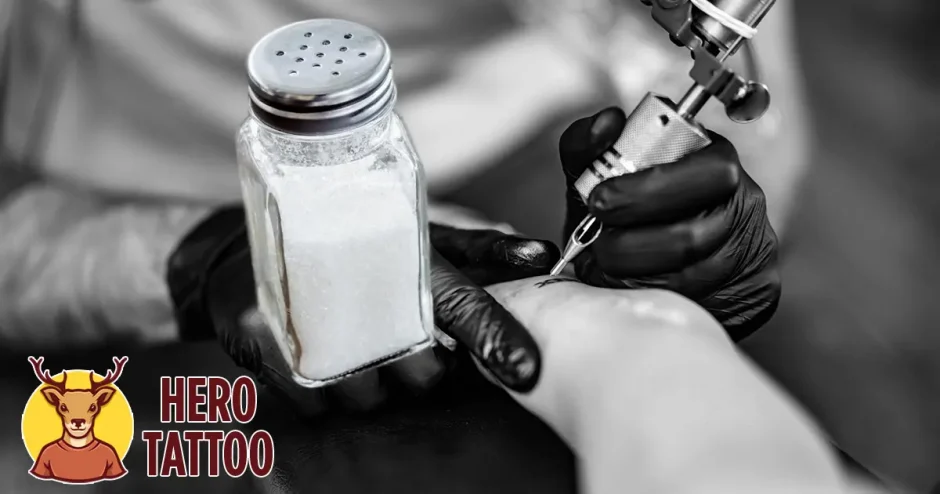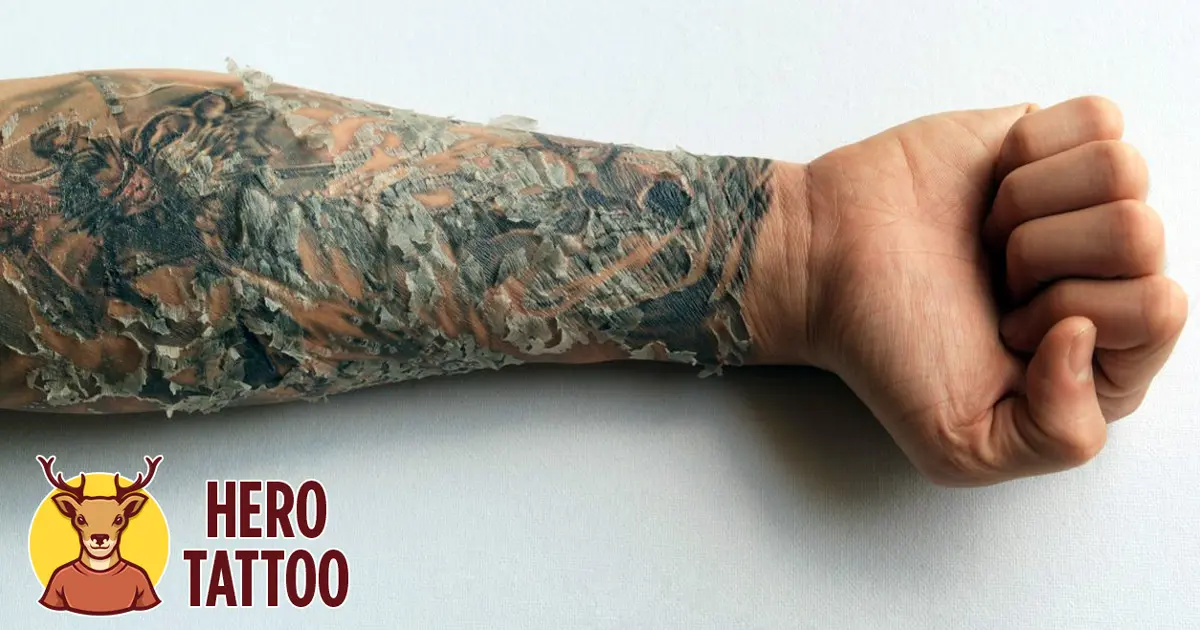Many ideas and methods are floating around the internet on how to erase a tattoo quickly and easily using things found in your kitchen or bathroom. Salt is an example of a frequent commodity. Putting salt into a tattoo will cause the ink to bleed out of the skin and fade, as many people believe. Is it, however, feasible for anything like this to happen? And, if so, isn’t it potentially dangerous?
As we go, we’ll look at this well-known Internet tattoo removal tip to see whether it’s safe and effective or whether it’s potentially hazardous. We’ll debunk the myths around this method and demonstrate what you need to do to have a good tattoo removal. So let’s get this party started!
Five Things You Should Know About Salt Tattoo Removal
1. Why Is It a Popular Recommendation On The Internet?
There are many reasons why tattoo removal methods and procedures using sugar or salt are so popular and why they are spreading like wildfire throughout the internet and in person. As an illustration;
- People who have no genuine knowledge of tattoos and how they operate promote untrue rumors about ‘fast and straightforward removal’ methods for salt tattoo removal.
- People who are ignorant about the skin layers and the locations where the tattoo ink is kept in the skin freely give their advice, which has the potential to harm other individuals.
- The opinions of those who feel that proper laser tattoo removal is ineffectual and pointless are shared, as are money-saving strategies for removing tattoos using just salt.
- People assume that because saltwater promotes tattoo fading, it will also assist them in completely removing the tattoo.
These are the four most typical causes for the existence of these salt tricks. The regular usage of salt around the house inspires uninformed individuals to develop ideas for tattoos, believing that it can be applied to the skin in the same way. As a result, before engaging in any activity that may be harmful to one’s skin or health, one should conduct an extensive study and contact specialists and authorities. Detailed information about this will be provided in the following paragraphs.
2. Is it possible to remove tattoos with salt?
The popularity of salt tattoo removal can be attributed to the fact that it is based on a process that is sometimes used to erase tattoos. Dermabrasion is the term used to describe the procedure. This exfoliation procedure to erase scars, acne, tissue abnormalities, and tattoos, among other things, is becoming more popular. It entails using sanding equipment that looks similar to salt/sugar crystals to remove the top skin layers.
Based on this, it is considered that salt alone can accomplish the same exfoliating effect as the other ingredients. salabrasion is a technique in which salt is used to achieve thorough exfoliation, and it is pretty compelling. However, one thing to keep in mind is that the tattoo ink is not applied directly to the skin’s surface. When the tattoo gun is used, it is pushed into the skin’s dermis, which is the layer of skin just under the surface, where the salt will not penetrate no matter how hard you scrub the salt away.
So, how effective is salt tattoo removal? Of course, it doesn’t work that way. Sometimes, even dermabrasion does not provide results due to the factors listed above. It is impossible for salt or any other sanding method to reach the inner skin layer where the tattoo ink is hidden.
Other variables that contribute to the ineffectiveness of salt tattoo removal include the following:
- The larger the tattoo, the greater the amount of salt exfoliation required, resulting in large scars and even dangerous skin damage.
- If a tattoo is placed in a tranquil spot, where the skin is thin and contains many nerve endings, the patient may endure significant pain and more severe damage.
- Salt will never penetrate the skin’s dermis, and even if you manage to massage it in, it will never be able to remove all of the ink, save from blood and plain.
3. Is it safe to use salt to remove tattoos from the body?
Salt, commonly used for skin exfoliation, is not considered harmful. Everyday use in the beauty industry is the use of salt and sugar body scrubs to remove old, dead skin cells and the achievement of smooth and supple skin.
On the other hand, repeated exfoliation of a single skin region, over and over again, can result in a variety of negative consequences. In the case of salt, constantly pressing it into the skin can result in bruising, inflammation of the skin and the tattoo, irritation, edema, redness, permanent scarring, and other forms of severe skin damage. Aside from discomfort, it can also cause pigmentation problems and other problems.
Not to mention that, as previously said, using salt for tattoo removal is entirely worthless. Thus there is no need for anybody to attempt this procedure at all.
4. Other Things To Consider Regarding Salt Tattoo Removal
During the research for this post, I came across a few cases when people stated that salt was the most effective method of erasing new tattoos. We’ve decided to underline how potentially harmful this may be.
Fresh tattoos are now treated as though they were open wounds. They must be safeguarded, cared for, and allowed to recuperate correctly. Unless you do, the tattoo or any damage to your skin might swiftly turn on you and cause serious health concerns.
Consider the sensation of putting salt into a new wound. Yes, it must be not easy even to contemplate this situation. The success of rubbing salt into a fresh tattoo is similar to this.
Undoubtedly, doing so increases the risk of severe infection, excessive bleeding, excessive tattoo ooze, skin damage, irritation, and longer healing time, which increases the risk of disease. The list continues on and on.
Apart from these side effects, a person may experience a significant fever and require immediate medical assistance to get the tattoo removed from their body.
Additionally, there have been cases when people have advocated using a scrubbing/bathing brush to massage in salt for the best results possible. This may be particularly harmful since a meeting can potentially introduce a large number of germs into the tattooed area. This can increase the severity of the illness and the likelihood of severe adverse effects.
So make a point of never attempting any of these activities. Continue reading because we’ll discuss an appropriate and proper tattoo removal process in the coming paragraphs. Also, be on the lookout for misleading information circulating on the internet; the knowledge that individuals post is highly harmful and health-threatening.
5. What Can I Do To Get Rid Of a Tattoo?
The only form of tattoo removal that is successful is laser removal therapy. Laser removal works by using a laser to penetrate the skin, reach the ink, and heat it to remove the ink. Next, the laser equipment emits shock waves, which distribute the ink throughout the surrounding tissue, completing the process. The ink particles are subsequently expelled from your body through the usual filtering of foreign substances (peeing and pooping).
Laser removal does have certain drawbacks as well as perks. It is no secret that laser removal treatments have also been linked to the development of scarring. On the other hand, individuals only experience this when they seek treatment at low-quality clinics staffed by unqualified personnel.
Furthermore, it is pretty expensive and requires numerous sessions until the tattoo is gone. Not to mention that the effectiveness of tattoo removal is dependent on the color of the ink used; if your tattoo is brightly colored, you will have a more difficult time removing it. The laser cannot distinguish between bright and dark ink as effectively as it can distinguish between dark and colorful ink.
However, despite all possible drawbacks, laser tattoo removal remains the most efficient method of permanently removing a tattoo. When competent specialists execute the treatment, the likelihood of experiencing adverse effects is virtually non-existent. This method is considered superior to the DIY salabrasion since it is non-invasive to the health and less intrusive to the environment.
Concluding Remarks
Tattoo removal that is temporary in nature might be pretty enticing to those who wish to get rid of a tattoo in a short period. On the other hand, Tattoo removal is not attainable in a short period. It takes time, mainly because the ink is implanted deep into the skin, which is challenging to access readily. On the other hand, laser tattoo removal is highly efficient and safe, making it your best alternative for the time being.
Hopefully, a breakthrough in laser tattoo removal will be made shortly, making laser tattoo removal more efficient and more accessible to more people. But, until then, refrain from attempting any of the internet’s most popular DIY tattoo removal methods and procedures. They are blatantly harmful and health-threatening, not to mention dishonest and deceptive in their claims.
Please refer to our other articles on tattoo removal and your dermatologist or even your tattoo artist for further information on effective removal. They will assist you in exploring your removal alternatives and determining which would be the most beneficial for you.
It is better to give than to receive!






